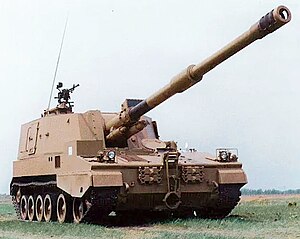PLZ-45
| PLZ45 Self-Propelled Howitzer | |
|---|---|
 Chinese PLZ-45 Self-Propelled Howitzer | |
| Type | Self-propelled artillery |
| Place of origin | China |
| Service history | |
| Wars | 2015 Military Intervention in Yemen. |
| Production history | |
| Designer | NORINCO |
| Designed | 1980s - early 1990s |
| Manufacturer | Norinco |
| Produced | 1997 |
| Specifications | |
| Mass | 33 tonnes [1] |
| Length | 10.5 m (34 ft 5 in) [1] |
| Width | 3.3 m (10 ft 10 in) |
| Height | 2.6 m (8 ft 6 in) with AAMG |
| Crew | 5 |
| Caliber | 155 mm (6.1 in) (45 calibre) |
| Traverse | 360° |
| Rate of fire | Maximum: 5 rounds/min Sustained: 2 rounds/min |
| Effective firing range | (HE) 24km; (ERFB) 30km; (ERFB-HB-BB) 39km |
| Armor | Protection against small arms fire and artillery shell splinters |
Main armament | 155 mm howitzer |
Secondary armament | 12.7 mm heavy machine gun / 2 sets of 4-barrel grenade launchers |
| Engine | Deutz turbocharged air-cooled diesel engine. 525 hp (386 kW) |
| Power/weight | 15 hp / tonne |
| Suspension | torsion bar |
Operational range | 550 km [2] |
| Maximum speed | 55 km/h (on-road) [2] |
The PLZ-45 or Type 88 is a 155 mm self-propelled howitzer designed by Su Zhezi of 674 Factory, and developed by Norinco, 123 Factory (Heilongjiang Hua’an Industry Group Company), 127 Factory (Tsitsihar Heping Machine Shop), 674 Factory (Harbin First Machine Manufacture Limited Company) and Beijing Institute of Technology in the early 1990s for the export market. It is based on Norinco's Type 89 (PLL01) 155mm/45-calibre towed gun-howitzer.[2][3]
The PLZ-45 self-propelled howitzer is used by the People's Liberation Army of China, People's National Army (Algeria), Kuwaiti Army & Saudi Arabian Army.
Design
Armament
Operated by a crew of five (commander, gunner, two loaders and a driver), the PLZ-45 is armed with a 155mm, 45-calibre main gun, with a semi-automatic loader and an electrically controlled and hydraulically operated ram that enables projectile loading to take place at any angle of elevation with the charge being loaded manually. The turret has an elevation of +72 to -3 degrees with 360 degree traverse.[2]
Secondary weapons include a roof-mounted W-85 heavy machine gun and two sets of four-barrel smoke grenade launchers on the turret's side.
Ammunition is stored at the rear of the turret. A total of 30 rounds for the gun-howitzer and 480 rounds for the machine gun are carried on board. 24 howitzer rounds are carried in the loader and 6 rounds on the right side below the loader.
The fire-control system of the PLZ-45 includes an automatic laying system, optical sighting system, gun orientation and navigation system, and a GPS receiver.[2][3]
Munitions

The PLZ-45 howitzer fires a range of Extended Range Full Bore (ERFB) ammunition, including High Explosive (ERFB/HE), Base Bleed High Explosive (ERFB-BB/HE), ERFB-BB/RA, ERFB/WP, ERFB/Illuminating, ERFB/Smoke, and ERFB-BB/Cargo.[2][3]
China obtained the Russian Krasnopol laser-guided projectile technology in the 1990s, and successfully developed its own 155mm laser-guided ammunition. Designed to defeat armoured vehicles and weapon emplacements, the projectile has inertial mid-course guidance and semi-active laser homing. The projectile has a range of 3 – 20 km, and can hit a target by the first shot without registration.[2][3]
Combat
A standard PLZ-45 battalion consists of 3 batteries, each with 6 PLZ-45 self-propelled howitzers (SPH) and 6 PCZ-45 ammunition support vehicles (ASV). Each battery has a battery command post and 3 battery reconnaissance vehicles (BRV), both of which are based on the Type 85 APC. These are supported by W653A armored recovery vehicles, 704-1 artillery locating and fire correction radar, 702-D meteorological radar, and fire support maintenance vehicles.[3]
Propulsion
The PLZ-45 self-propelled howitzer is powered by a 525 hp Deutz turbocharged air-cooled diesel engine, giving a max road speed of 55 km/h (34 mph).[4]
Armor & Protection
The armor of the PLZ-45 self-propelled howitzer protects against small arms fire and artillery shell splinters. It is fitted with NBC protection and automatic fire suppression systems.[2]
Operational History
In 2015, the Saudi Army used the PLZ-45 to bomb Houthi rebels in western Yemen during the 2015 Military Intervention in Yemen. This was the first time the PLZ-45 has been used in combat.[5] In late 2015 Kuwait has sent an Artillery Battalion to the Saudi borders as a part of the intervention in Yemen.
Operators

Current Operators

 China: Used by the People's Liberation Army.[6]
China: Used by the People's Liberation Army.[6] Kuwait: (51) 27 PLZ-45's (to form a training platoon and the first battalion) ordered in 1998 and delivered in 2000 - 2001.[7][8] 24 more howitzers (to form the second battalion) were ordered in 2001 and delivered in 2002 - 2003.[7][8]
Kuwait: (51) 27 PLZ-45's (to form a training platoon and the first battalion) ordered in 1998 and delivered in 2000 - 2001.[7][8] 24 more howitzers (to form the second battalion) were ordered in 2001 and delivered in 2002 - 2003.[7][8] Saudi Arabia: (54) In 2007, it was reported that the Saudi Arabian Army had decided to order two battalions (54 units) of the PLZ-45 artillery system.[3] In August 2008, China signed a contract to provide Saudi Arabia with one battalion i.e. 27 PLZ-45 155mm self-propelled howitzers.[9][10] Another contract to supply one more battalion (27 more PLZ-45 self-propelled guns) was signed later in the month.[11] The howitzers were delivered between 2008-2009.[8]
Saudi Arabia: (54) In 2007, it was reported that the Saudi Arabian Army had decided to order two battalions (54 units) of the PLZ-45 artillery system.[3] In August 2008, China signed a contract to provide Saudi Arabia with one battalion i.e. 27 PLZ-45 155mm self-propelled howitzers.[9][10] Another contract to supply one more battalion (27 more PLZ-45 self-propelled guns) was signed later in the month.[11] The howitzers were delivered between 2008-2009.[8] Algeria: (50)[12] Ordered in 2013 and delivered in 2014.[13][14][15]
Algeria: (50)[12] Ordered in 2013 and delivered in 2014.[13][14][15]
Potential Operators
See also
References
- ^ a b "China Upgrades Self-Propelled Artillery". strategypage.com. July 25, 2010. Retrieved 20 April 2013.
- ^ a b c d e f g h "PLZ45 155-mm self-propelled howitzer". military-today.com. Retrieved 2013-04-18.
- ^ a b c d e f "PLZ45 155mm Self-Propelled Gun-Howitzer". sinodefence.com. 1 October 2008. Retrieved 15 April 2013.
- ^ "PLZ-45 self-propelled artillery". Federation of American Scientists.
- ^ "Saudis Use Chinese-made Cannons in Yemen". Retrieved 2015-05-17.
- ^ "China details latest PLZ52 155 mm self-propelled artillery system". Jane's International Defence Review. 18 October 2012. Archived from the original on 18 August 2013. Retrieved 11 April 2014.
{{cite journal}}: Cite uses deprecated parameter|authors=(help) - ^ a b V Cole, Stephen (24 November 2001). "Artillery Article Index - November 24, 2001". strategypage.com. Retrieved 19 April 2013.
- ^ a b c "Trade Registers - SIPRI".
- ^ Chang, Andrei (11 August 2008). "China to export guns to Saudi Arabia". Kanwa Daily News. Archived from the original on September 28, 2008. Retrieved 20 April 2013.
{{cite news}}: Unknown parameter|deadurl=ignored (|url-status=suggested) (help) - ^ "China wins key Saudi artillery contract". United Press International. 7 August 2008. Retrieved 15 April 2013.
- ^ "Chinese Guns Conquer Arabia". strategypage.com. 15 August 2008. Retrieved 16 April 2013.
- ^ http://armstrade.sipri.org/armstrade/page/trade_register.php
- ^ H. Shinn, David (26 February 2014). "Chinese Military Sales to Nigeria and Algeria". International Policy Digest. Retrieved 24 March 2014.
- ^ 中国凶猛:外媒惊曝中国先进大杀器到了北非 (in Chinese). 23 January 2014. Retrieved 3 February 2014.
- ^ Binnie, Jeremy (22 January 2014). "New self-propelled howitzer spotted in Algeria". Jane's Defence Weekly. Retrieved 6 April 2014.
- ^ Olimat, Muhamad (2012). China and the Middle East: From Silk Road to Arab Spring. Routledge. pp. 146–147. ISBN 9781135102210.
- ^ Rama Rao, Malladi. (24 January 2010). "Dynamics of China-Bangladesh relations". Policy Research Group. Retrieved 4 September 2013.

